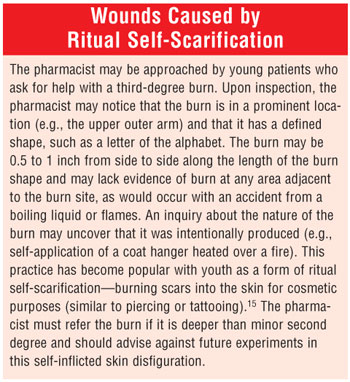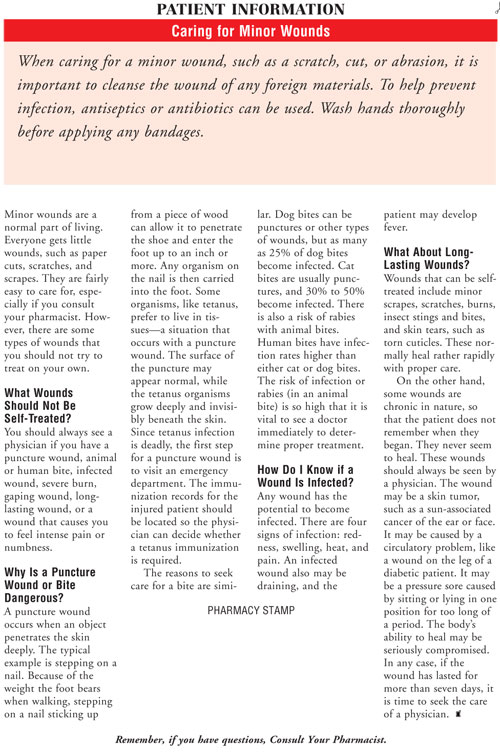US
Pharm. 2006;4:16-23.
Patients with wounds often ask
the pharmacist about care issues. These wounds include burns of all depths,
cuts, abrasions, and skin tears (e.g., on the cuticles). The wound may have
arisen due to an accident, self-mutilation, surgery, an animal bite or
scratch, a sports injury, or an insect bite or sting. This column discusses
issues related to the treatment of minor wounds.
When to Refer Wounds
The pharmacist
should refer wounds to a physician in several instances, including the
following:
• Puncture wounds or
animal bites.
• Burns that are more
severe than minor second degree.
• Gaping wounds that
may require stitches.
• Wounds that have
exposed fatty tissue, white tissue, or muscle.
• Wounds with visible
foreign material (dirt, plant material, glass, metal, or gravel).
• Wounds with blood
spurting from them.
• Wounds causing severe
pain or resulting in a numb feeling or inability to move structures below the
wound.
• New wounds in
patients with diabetes or bleeding problems.
• Chronic wounds that
do not heal.
• Infected wounds.
1-5
Chronicity of Wounds
The pharmacist
should ask about the duration of the wound. The FDA requires wound care
antiseptics and antibiotics to be labeled with the warning that they should
not be used beyond one week. Thus, a wound persisting longer than one week
requires referral. This ensures that these products will be used only on minor
wounds and not on those that are serious and chronic, such as pressure ulcers
or wounds on the legs of a diabetic patient.
Moist Versus Dry Wound
Healing
Recent medical
wisdom states that a moist wound will heal more rapidly and favorably than one
that is dry.6 If the wound is allowed to fully dry during healing,
cells on the leading edges may lose viability. Cells in lower tissues are left
to heal the wound from the moist tissues on the bottom upward to dead tissues.
7 This is the reason for the proliferation of wound dressings that can
keep the wound moist.

First Aid
One of the first
matters to address with minor wounds is cleansing the wound.3,8
Cleansing is important for incisions that are caused by sharp objects, such as
knives or broken glass. However, it is even more critical in abrasion
injuries, in which the skin's outer layers have been scraped away by abrasion
against a rough object, such as when elbows and arms scrape against pavement
during a skateboard fall. If the abrasion occurred on a surface that contains
loose materials, the wound is likely to be contaminated with gravel, dirt,
grass, and other foreign substances. Each foreign object remaining may serve
as a source of infection and should be removed.
The wound can be washed with
tap water under enough pressure to thoroughly cleanse the wound of foreign
materials. Wound Wash Saline is a pressurized sterile 0.9% sodium chloride
product that can accomplish this cleansing for minor wounds.
Antiseptics/Antibiotics
Application of an
antiseptic/antibiotic can help prevent infection in a minor wound. (These
products are not appropriate for an infected wound; self-treatment of any type
of bacterial skin infection [e.g., boils, folliculitis, impetigo] is
inappropriate and delays the patient from making a physician appointment.) The
FDA requires the following labeling on these products: "Stop use and consult a
doctor if the condition persists or gets worse. Do not use for longer than one
week unless directed by a doctor."9 Product labeling will
also caution patients against use in the eyes or over large areas of the body.
Safe and effective local antiseptics that are readily available include
denatured ethyl alcohol 48% to 95%, isopropyl alcohol 50% to 91.3%, hydrogen
peroxide 3% solution, tincture of iodine, povidone-iodine, and creams and
ointments containing polymyxin and bacitracin (e.g., Polysporin). Products
containing neomycin (e.g., Neosporin) should be avoided, as neomycin is a
potential cause of allergic dermatitis.10 Band-Aid
Antiseptic Foam is a one-step product for cleaning and disinfecting; its
antiseptic ingredient is 0.13% benzalkonium chloride. A note of caution is
necessary for the ingredient triclosan. Its popularity is unparalleled among
antimicrobial hand cleansers, but it can cause resistance in such organisms as
Staphylococcus aureus.11-13
Local Anesthetics
Patients may
request relief for the minor pain of scratches, scrapes, and minor burns. Some
antibiotic ointments incorporate local anesthetics in neomycin-free formulas
(e.g., Betadine Plus First Aid Antibiotics + Pain Reliever Ointment, with
polymyxin, bacitracin, and pramoxine). Patients could also choose a
polymyxin/bacitracin cream or ointment and use a separate local anesthetic
product. An innovative method to prevent pain is the application of tissue
adhesives. These "superadhesive" cyanoacrylate polymers have been used in
surgical procedures since the late 1990s and are superior to sutures in
closing wounds. A leading product is Band-Aid Liquid Bandage. The patient
applies it to a minor laceration, abrasion, friction blister, hangnail, paper
cut, or cracked finger using the activator provided. The product reduces the
time of wound closure, provides instant hemostasis, and seals off damaged
nerve endings, which reduces pain. The adhesive serves as a barrier to wound
contamination during its five- to 10-day duration on the skin before it is
shed along with the surface layer of skin cells.
Types of Wound Dressings
Nonadherent
Dressings: An
abrasion may have exudate issuing from it. If the patient applies most types
of dressings directly over the area, exudate may become encrusted in the
bandage. Subsequent removal can damage the healing wound. The pharmacist can
recommend a nonadherent dressing over a minor wound with drainage. The
nonadherent nature is achieved through impregnation with petrolatum or the use
of a specially constructed rayon-polyethylene laminate. Such products as
Adaptic Non ad her ing Dressing, Vaseline Gauze, Nexcare Non-Stick
Pads, Release Non-Adhering Dressing, and Telfa Pads are easily removed when
the dressing needs to be changed but do not absorb exudates from draining
wounds.
Primary Dressings:
Wounds can be covered with a primary dressing--a type of bandage with a small
degree of absorbency for lightly draining wounds or those with no drainage.
Their absorbency wicks drainage away from wounds to minimize the risk of
exudate adherence. They also provide some protection for the wound and cover
it for purposes of aesthetics. Primary dressings include the Kerlix Sponge,
Sof-Wick Drain Sponge, Sof-Wick Dressing Sponge, Steri-Pad, and Topper
Dressing Sponge. The set of products marketed under the Band-Aid trade name is
a veritable cornucopia of primary dressings. A major advantage of Band-Aid
products is that they are manufactured with the tape needed to secure them to
the wound, while most other primary dressings require separate tape. Band-Aid
products range from standard sizes (e.g., rectangular or round pads) to those
with pads impregnated with polymyxin and bacitracin (Band-Aid Plus
Antibiotic). Other products have waterproof seals to speed wound healing
(Band-Aid Activ Flex).
Secondary Dressings:
These dressings are advisable when a wound is producing moderate to heavy
drainage. They are absorbent materials (e.g., gauze or cotton) and cannot be
placed directly over a wound, since they will yield fibers that could hamper
wound healing. However, when placed over a primary dressing, they provide
added absorb ency, increas ed compression, and enhanced protection from
environmental contaminants.
Most minor wounds would not
produce drainage heavy enough to require a secondary dressing; thus, secondary
dressings are seldom necessary for accidental wounds for which self-care is
appropriate. However, the trend to discharge surgical patients on the day of
surgery, or very soon thereafter, has created a compelling need for them. The
individual changing the postsurgical wound dressing may be a family member
with no medical training or understanding of even the most basic principles of
wound care. The pharmacist must stress the need to wash hands thoroughly
before applying the dressing, to keep all dressings wrapped prior to
application, and to not touch the side of any primary dressing that will face
the wound before applying the secondary dressing.
Tapes
Dressings that do
not have a self-contained adhesive will require tape to secure them to the
skin. Patients should be advised against the use of old "adhesive" tapes, as
they have a stiff backing that can damage skin during removal and are prone to
be allergenic. Rather, the patient should choose any of several hypoallergenic
tapes. These have light adhesives that are gentler on skin with repeated bouts
of application and removal. An allergic reaction on broken skin may also
retard healing.
Silver as an Antiseptic
Silver nitrate and
other silver products, such as colloidal silver, have been traditionally used
as antiseptics for many years. The FDA, in its sweeping review of
nonprescription products, addressed the safety and efficacy of silver products
for self-care in a final rule published in the Federal Register in 1999.
14 The agency stated that many products containing colloidal silver or
silver salts were being marketed to treat numerous serious disease conditions,
and the FDA was unaware of any evidence to support these therapeutic claims.
It ruled that products containing silver would be subject to regulatory action
after September 16, 1999. In addition, the agency explained that topical
silver products cannot be marketed as dietary supplements under the Dietary
Supplement Health and Education Act of 1994, since this law pertains only to
orally ingested products. Yet, silver products continue to be marketed. Even
now, in 2006, a Google search of the Internet using the term "colloidal
silver" returns over two million hits, many directing the reader to sites
still promoting unproven claims. Furthermore, a product known as Curad Silver
Bandages is being promoted as an effective antibacterial for wound care. Until
topical silver products are ruled to be safe and effective for wound care by
the FDA, this product should not be recommended.

REFERENCES
1. Taplitz RA.
Managing bite wounds: currently recommended antibiotics for treatment and
prophylaxis. Postgrad Med. 2004;116:49-52, 55-56, 59.
2. Ayello EA. What does
the wound say? Why determining etiology is essential for appropriate wound
care. Adv Skin Wound Care. 2005;18:98-109.
3. Wound care guide.
McKinley Health Center. Available at: www.mckinley.uiuc.edu/handouts/
wound_care/wound_care.html. Accessed February 27, 2006.
4. Tomaselli NL.
Teaching the patient with a chronic wound. Adv Skin Wound Care.
2005;18:379-387.
5. Wound infection.
Nurs Times. 2005;101:32.
6. Scanlon E. Wound
infection and colonisation. Nurs Stand. 2005;19:57-67.
7. Ayello EA, Dowsett
C, Schultz GS, et al. Time heals all wounds. Nursing. 2004;34:36-41.
8. Dulecki M, Pieper B.
Irrigating simple acute traumatic wounds: a review of the current literature.
J Emerg Nurs. 2005;31:156-160.
9. Pray WS. Minor
wounds. In: Pray WS. Nonprescription Product Therapeutics. 2nd ed.
Baltimore: Lippincott Williams & Wilkins; 2005:520-538.
10. Menezes de Padua
CA, Schnuch A, Lessmann H, et al. Contact allergy to neomycin sulfate: results
of a multifactorial analysis.Pharmacoepidemiol Drug Saf.
2005;14:725-733.
11. Levy SB.
Antibacterial household products: cause for concern. Available at:
www.cdc.gov/ncidod/eid/vol7no3_supp/levy.htm. Accessed February 27, 2006.
12. Aiello AE, Marshall
B, Levy SB, et al. Antibacterial cleaning products and drug resistance.
Available at: www.cdc.gov/ncidod/EID/vol11no10/04-1276.htm. Accessed February
27, 2006.
13. Suller MT, Russell
AD. Triclosan and antibiotic resistance in Staphylococcus aureus. J
Antimicrob Chemother. 2000;46:11-18.
14. Over-the-counter
drug products containing colloidal silver ingredients or silver salts. Fed
Reg. 1999;64:44653-44658.
15. Armstrong ML.
Caring for the patient with piercings. RN. 2004;67:46-48, 50-52.
To comment on this article,
contact
editor@uspharmacist.com.






